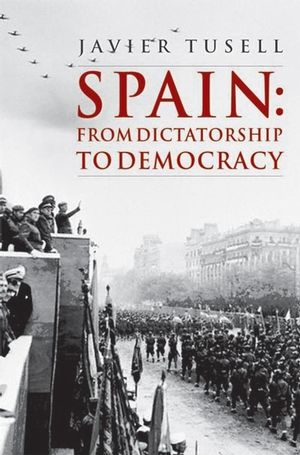Spain: From Dictatorship to DemocracyISBN: 978-0-631-20615-6
Hardcover
504 pages
July 2007, Wiley-Blackwell
 Other Available Formats: Paperback
|
||||||
Introduction.
Franco: Biography and Political Practice.
Francoism: A Form of Dictatorship.
Victors and Vanquished: The Disasters of the Civil War and Repression.
Exile and the Start of the Postwar Period in Spain.
Bibliography.
Notes.
1. The Temptation of Fascism and the Will to Survive (1939–51).
A Failed Attempt to Make Spain Fascist.
The Temptation to Intervene and Internal Conflict (1940–2).
Stumbling Progress towards Neutrality (1942–5).
Cosmetic Change: Regime Politics between 1945 and 1951.
Opposition from Survivors: The Spanish Left from 1939 to 1951.
The Monarchist Alternative.
Franco in Isolation.
The “Dark Night”: Autarchy and Rationing in the 1940s.
Culture: Penance and Survival.
Bibliography.
Notes.
2. The Years Of Consensus: The High Point of the Regime (1951–65).
The End of International Isolation: The Concordat and Pacts with the United States.
Spain and Europe: Colonization of Morocco Ends.
The Regime and the Opposition up to 1956.
A New Political Opposition.
For or against Falange: Political Life under the Regime between 1956 and 1965.
The Easing of Autarchy and the Change in Economic Policy.
From Political Opposition to Social Opposition.
Culture in the Francoist Middle Period: The End of the Penitential Years.
Daily Life and Leisure Activities.
Bibliography.
Notes.
3. Economic Development, Apertura, and the Late Franco Years (1966–75).
Economic Development in the 1960s and 1970s.
The Modernization of Spanish Society.
The Change in Spanish Catholicism.
Apertura (1965–9).
The Succession. Matesa and Internal Splits in the Regime.
Worker Protest. Terrorism.
The Late Franco Period: Carrero Blanco as President.
Late Francoism: Arias Navarro’s Government.
Opposition Activity: The Road to Unity.
Spain and the Western World.
Late Decolonization: Guinea and the Sahara.
A Politically Committed Culture?.
Spain at the Time of Franco’s Death.
Bibliography.
4. The Transition to Democracy (1975–82).
The Monarchy: King Juan Carlos I.
The Death-throes of the Past.
Adolfo Suárez: The Road from Liberalization to Democracy.
Facing Difficulties: Terrorism and the Military Coup.
Parties and Elections.
The Long Road towards a Constitution.
An Unresolved Issue: Nationalism and Terrorism.
The Triumph and Fall of Adolfo Suárez.
The Army and the Transition: February 23.
Calvo Sotelo’s Government and the Crisis in Center Politics.
Foreign Policy.
Economic Policy and Social Change.
October 1982: The End of the Transition.
Bibliography.
5. Consolidating Democracy: The Socialist Government (1982–96).
Felipe González and the Two Souls of Spanish Socialism.
The Socialists’ First Term in Office. Reform of the Armed Services, an Economic Update and Foreign Policy.
A Means of Consolidating Democracy. The GAL.
Elections and Public Opinion in the Second Half of the 1980s.
The Second Term in Office: Social Policies and Union Protests. Spain and the World.
Policy on the Autonomous Communities: A New Vertebrate Structure for the Spanish State.
The Loss of an Absolute Majority.
A Tense Term of Office (1993–6).
The 1996 General Election. Drawing up the Balance on the Socialists’ Time in Government.
Culture in the Post-Franco Period.
From a Time of Rediscovery to a State Culture.
Fields of Creativity.
Bibliography.
6. The Turn of the Right (1996–2004).
The Popular Party in Power: José María Aznar.
Success in Economic and Social Policies.
The Dark Side of the Right.
A Pluralistic Spain: Nationalities and Terrorism.
Government and Opposition. The Elections in March 2000.
The Style of Government with an Absolute Majority.
The Limits of PSOE Renewal.
Dramatic Basque Elections.
The Policy of Making Pacts and Breaking with Consensus.
The PP: Idyllic Peace and Neo-conservatism.
From More to Less: Government Policy in the Second Four-year Term.
The Final Straight.
Bibliography.
Notes.
Index.



